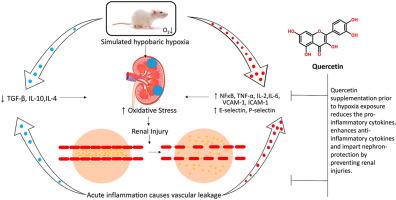Mitigation of hypobaric hypoxia induced renal inflammatory alterations by quercetin prophylaxis
IF 3
3区 医学
Q1 INTEGRATIVE & COMPLEMENTARY MEDICINE
Journal of Traditional and Complementary Medicine
Pub Date : 2025-09-01
DOI:10.1016/j.jtcme.2024.06.008
引用次数: 0
Abstract
The objective of the present study is to decipher the role of NF-κB and its associated downstream genes involved in causing inflammation in kidneys of rats under acute hypobaric hypoxia exposure. The study also aims at finding out the efficacy of quercetin in comparison with dexamethasone in prevention of hypobaric hypoxia induced renal inflammation. Sprague Dawley (SD) rats (n = 6) were preconditioned with 50 mg/Kg BW of quercetin, 1 h prior to hypobaric hypoxia exposure (12 h). The results revealed a significant increase in reactive oxygen species (ROS) generation and malondialdehyde (MDA) (p < 0.001) levels along with down regulation of GPx and SOD levels in kidney tissue of hypobaric hypoxia exposed rats as compared to control. However, ROS production and MDA levels in kidney tissues were reduced significantly (p < 0.001) with enhanced antioxidant enzyme levels (GPx and SOD) in rats fed with quercetin as compared to hypobaric hypoxia exposed control (p < 0.001). Protein expression analysis through western blotting and EMSA performed in nuclear extracts of kidneys, exhibited a significant upregulation of NF-κB under hypobaric hypoxic stress as compared to control. Whereas pretreatment with quercetin aids in downregulation of NF-κB expression in kidneys of rats as compared to the hypobaric hypoxia exposed group. Further, quercetin prophylaxis significantly reduced the expression of pro-inflammatory cytokines (TNF-α, IL-2 and IL-6), increased the anti-inflammatory cytokines (IL-10, IL-4 and TGF-β) along with reduced expression of cell adhesion molecules (ICAM-1, VCAM-1, E-selectin and P-selectin) in kidneys of rats under hypobaric hypoxia as compared to hypobaric hypoxia control. However, pre-treatment with dexamethasone was not as effective as quercetin, in controlling the renal inflammation. Furthermore, improved hematological parameters such as WBC, RBC, and platelet count indicated that quercetin is a well-functioning effective molecule under hypobaric hypoxic exposure. The histopathological and TEM findings, manifested the structural changes in tubular arrangements in kidneys of rats, and these changes were found to be modified by quercetin prophylaxis under hypobaric hypoxic stress. Hence, the present study indicates that, quercetin can be considered as a potential phytochemical flavonoid moiety in preventing the acute renal inflammation under hypobaric hypoxia.

槲皮素预防减轻低压缺氧引起的肾脏炎症改变
本研究的目的是破译NF-κB及其相关下游基因在急性低压缺氧暴露大鼠肾脏炎症中的作用。并比较槲皮素与地塞米松对低氧缺氧致肾炎症的预防作用。SD大鼠(n = 6)在低压缺氧暴露前1小时(12小时)给予50 mg/Kg BW槲皮素预处理。结果显示,与对照组相比,低气压缺氧暴露大鼠肾脏组织中活性氧(ROS)和丙二醛(MDA)水平显著增加(p < 0.001), GPx和SOD水平下调。然而,与低氧暴露对照组相比,槲皮素喂养的大鼠肾脏组织中ROS生成和MDA水平显著降低(p < 0.001),抗氧化酶(GPx和SOD)水平升高(p < 0.001)。通过western blotting和EMSA对肾脏核提取物进行的蛋白表达分析显示,与对照组相比,低氧缺氧应激下NF-κB显著上调。与低氧暴露组相比,槲皮素预处理有助于下调大鼠肾脏NF-κB的表达。此外,与低氧对照组相比,槲皮素预防显著降低了低压缺氧大鼠肾脏中促炎因子(TNF-α、IL-2和IL-6)的表达,增加了抗炎因子(IL-10、IL-4和TGF-β)的表达,降低了细胞粘附分子(ICAM-1、VCAM-1、e -选择素和p -选择素)的表达。然而,地塞米松预处理在控制肾脏炎症方面不如槲皮素有效。此外,改善的血液学参数,如白细胞、红细胞和血小板计数表明,槲皮素在低压缺氧暴露下是一个功能良好的有效分子。组织病理学和透射电镜结果显示,大鼠肾小管排列结构发生改变,这种改变被槲皮素预防在低压缺氧应激下改变。因此,本研究提示槲皮素可能是一种潜在的植物化学类黄酮片段,具有预防低氧缺氧急性肾炎症的作用。
本文章由计算机程序翻译,如有差异,请以英文原文为准。
求助全文
约1分钟内获得全文
求助全文
来源期刊

Journal of Traditional and Complementary Medicine
Medicine-Complementary and Alternative Medicine
CiteScore
9.30
自引率
6.70%
发文量
78
审稿时长
66 days
期刊介绍:
eJTCM is committed to publish research providing the biological and clinical grounds for using Traditional and Complementary Medical treatments as well as studies that demonstrate the pathophysiological and molecular/biochemical bases supporting the effectiveness of such treatments. Review articles are by invitation only.
eJTCM is receiving an increasing amount of submission, and we need to adopt more stringent criteria to select the articles that can be considered for peer review. Note that eJTCM is striving to increase the quality and medical relevance of the publications.
 求助内容:
求助内容: 应助结果提醒方式:
应助结果提醒方式:


